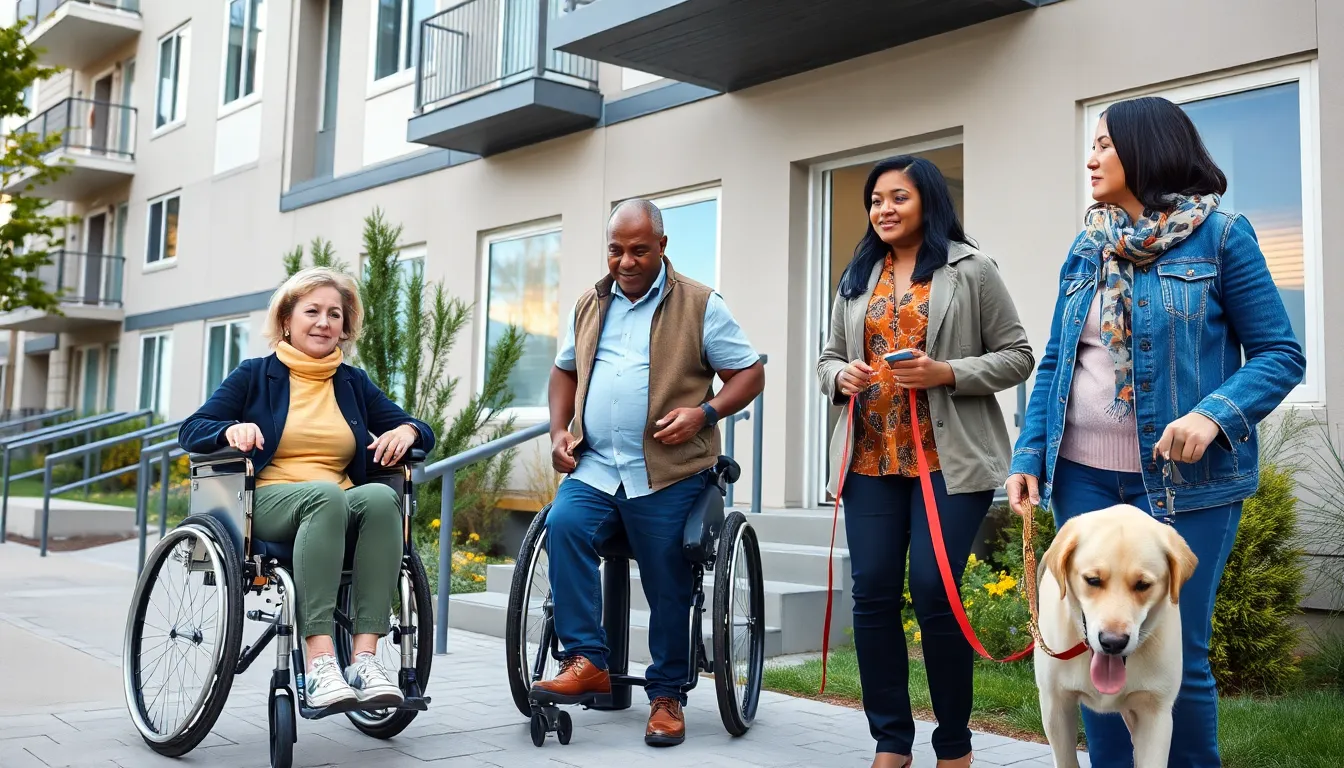Navigating the world of rental properties can feel like deciphering an ancient scroll, especially when it comes to ADA rental requirements. While most landlords are focused on profit margins and tenant screening, they often overlook the essential need for accessibility. It’s not just a legal hurdle; it’s about creating spaces that everyone can enjoy.
Imagine a world where your rental property welcomes all, from the adventurous grandma in a wheelchair to the aspiring rock climber with a temporary injury. Embracing ADA standards isn’t just good karma; it can boost your property’s appeal and marketability. So let’s dive into the essentials of ADA compliance and discover how to turn your rental into an inclusive haven, all while keeping those rental checks rolling in.
Table of Contents
ToggleOverview of ADA Rental Requirements
ADA rental requirements mandate that landlords ensure accessibility for individuals with disabilities. First, compliance with specific design standards is essential. Properties must include accessible parking, pathways, and entrances to accommodate tenants.
Next, common areas also require proper modifications. Elevators need to be installed in multi-story buildings, and doorways should be wide enough to allow wheelchair access. Restrooms must have accessible stalls equipped with grab bars and adequate turning space.
Furthermore, communication accessibility plays a role. Properties should offer visual alarms and other notification systems to assist tenants with hearing impairments. Providing Braille signage can enhance navigation for tenants with visual disabilities.
Landlords often misunderstand their responsibilities regarding reasonable accommodations. Requests for modifications or assistance animals must be considered seriously and addressed promptly. It’s crucial to understand that these accommodations support tenant rights under ADA.
Monitoring compliance is equally important. Regular inspections can identify areas needing improvement. Landlords who prioritize accessibility not only fulfill legal obligations but also attract a broader tenant base, ultimately boosting property marketability.
Embracing these requirements demonstrates a commitment to inclusivity and community wellbeing. Rental properties that meet ADA standards stand out in competitive markets. Adopting these practices helps create welcoming environments for everyone, regardless of their physical abilities.
Key Provisions of ADA
The ADA lays out essential provisions that ensure access for everyone, particularly in rental properties. Understanding these provisions ensures compliance and promotes inclusivity.
Accessible Design Standards
Accessible design standards emphasize that buildings must accommodate individuals with disabilities. Features like accessible entrances, hallways, and restrooms are vital. Landlords must ensure that pathways and parking areas meet specifications. Elevators are necessary in multi-story buildings to facilitate movement. Including ramps and accessible devices enhances usability for all residents. Property owners should regularly evaluate their spaces to meet or exceed these standards, as non-compliance can deter potential tenants.
Communication Access
Communication access is crucial for tenants with disabilities. Implementing visual alarms benefits those with hearing impairments. It’s important for property managers to provide Braille signage for visually impaired individuals. Sign language interpreters can also be helpful during meetings or events. Providing written materials in accessible formats supports all residents. Regular training for staff on communication access enhances understanding and responsiveness. By prioritizing these aspects, landlords foster an inclusive environment that benefits everyone.
Responsibilities of Landlords
Landlords play a crucial role in ensuring ADA compliance in rental properties. They must implement necessary modifications and accommodations to meet the needs of tenants with disabilities.
Modifications and Accommodations
Landlords must provide reasonable modifications when required by tenants. Some examples include allowing grab bars in bathrooms, ramps for entry, and wider doorways for mobility devices. It’s essential to understand that costs for reasonable modifications often fall to the landlord unless the tenant requests a specific change. Recognizing the importance of assistance animals further supports inclusivity in rental settings. Landlords should ensure that policies facilitate this process, making the environment welcoming and supportive.
Maintenance of Accessibility Features
Maintaining accessibility features is just as vital as implementing them. Regular inspections help identify wear and tear on essential features like elevators and ramps. Timely repairs keep these elements functional, ensuring continuous compliance with ADA standards. Training staff on proper usage and maintenance of accessibility features fosters accountability. Landlords must document any maintenance efforts to demonstrate adherence to accessibility requirements. Keeping records also aids in tracking progress and addressing potential issues proactively.
Tenant Rights Under ADA
The Americans with Disabilities Act ensures important rights for tenants with disabilities. These rights establish a legal foundation for accessibility in rental properties.
Rights to Request Modifications
Tenants hold the right to request reasonable modifications to their living spaces. Landlords must accommodate changes like installing grab bars or widening doorways. Even if modifications may alter the property’s structure, landlords bear the responsibility to make these changes unless the tenant requests them. Costs typically fall on the landlord, ensuring no tenant faces financial burden for necessary accessibility adjustments. For instance, if a tenant requires a ramp, the landlord needs to evaluate the request promptly. Clear communication about these rights empowers tenants to advocate for their needs.
Protection Against Discrimination
Discrimination against tenants with disabilities is prohibited under the ADA. Landlords cannot refuse to rent or deny services based on disability status. Legal protections extend to all aspects, including terms and conditions of tenancy, ensuring equal treatment. For example, charging higher fees solely based on a tenant’s disability violates ADA regulations. The law mandates that landlords foster an inclusive environment, providing equal opportunities for all individuals. Awareness of these protections enhances tenant confidence and reinforces equitable treatment within rental communities.
Implications for Real Estate Professionals
Real estate professionals play a pivotal role in ensuring ADA compliance for rental properties. Understanding legal obligations and compliance requirements enhances property marketability.
Understanding Compliance Obligations
Landlords must familiarize themselves with specific ADA standards for accessible design. Modifications such as accessible parking spaces, ramps, and wider doorways are essential for fulfilling legal obligations. Properties with multi-story structures require elevators to accommodate all tenants. Regular evaluations of accessibility features help maintain compliance and attract prospective tenants. Monitoring federal and local regulations ensures landlords stay informed about changing requirements.
Best Practices for Property Management
Implementing best practices simplifies ADA compliance management. Training staff on accessibility standards fosters an inclusive environment that benefits everyone. Regular maintenance checks on ramps and elevators ensure functionality and avoid potential violations. Establishing clear procedures for tenant requests for reasonable modifications promotes open communication. Documenting compliance efforts builds a reliable record that demonstrates commitment to accessibility. Prioritizing these actions not only fulfills legal duties but also enhances the overall tenant experience.
Conclusion
ADA rental requirements play a crucial role in fostering inclusive communities. By prioritizing accessibility landlords not only meet legal obligations but also enhance their properties’ appeal. Implementing necessary modifications and ensuring ongoing compliance can significantly improve tenant satisfaction and broaden the tenant base.
Regular maintenance and staff training are essential for sustaining accessibility features. Understanding tenant rights under the ADA empowers individuals and promotes equitable treatment within rental settings. As landlords embrace these standards they contribute to a more inclusive environment that benefits everyone. Ultimately the commitment to ADA compliance reflects a dedication to community wellbeing and responsible property management.







